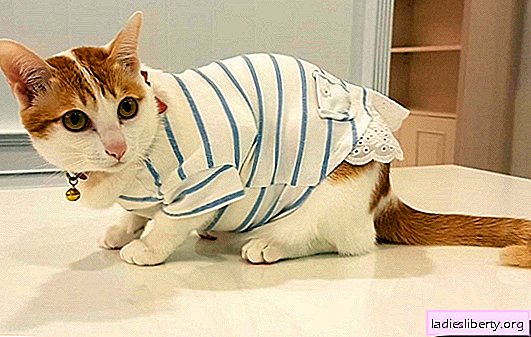
Pyometra in cats is a common and very dangerous disease that can occur in any pet. So, pyometra in cats - what is it and how is it treated?
This disease is a type of purulent endometritis, that is, it is an inflammation of the uterus that occurs with the accumulation of pus. It is very dangerous for the animal, without proper treatment, it can be fatal. Danger threatens all unsterilized cats. It was previously believed that if a cat is older than five years old or has already given birth, then she cannot get such inflammation. However, it has now been proved that it is possible to defend against it only by sterilizing the cat, while removing both the uterus and both ovaries.
Causes of Pyometers in Cats
The main reason for pyometers in cats is a malfunction in the hormonal system. But also the owners themselves can provoke the disease. The following options can cause inflammation:
1) Diseases of the genitourinary system that have not been completely cured and in the form of complications give inflammation of the uterus.
2) Endometritis if proper treatment has not been provided.
3) Long-term use of hormonal drugs. These primarily include means of "stop sex", aimed at controlling estrus.
4) Knitting with an unhealthy cat or the absence of any control in general.
5) During estrus, the cat was in unsanitary conditions.
6) Injury or infection during childbirth.
7) Infections such as cocci bacteria in the body of the pet.
Symptoms of pyometers in cats
The first symptoms usually appear a couple of months after estrus in a cat, since during this period the most favorable conditions for the reproduction of pathogenic bacteria arise.
Symptoms depend on the nature of the inflammation. Pyometers form when the cervix is open. Then the following symptoms can be distinguished:
1) copious discharge from the vulva, can be easily determined by the brown spots that the cat leaves behind;
2) the cat very often licks, almost every 15-20 minutes;
3) temperature increase;
4) refusal of food and increased thirst.
The second form - it is with the cervix closed, is much more complicated and more pronounced, since pus accumulates inside. Symptoms
1) the discharge is absent or almost insignificant;
2) a strong increase in the abdomen, it becomes painfully large and elastic;
3) temperature increase;
4) refusal of food and increased thirst;
5) increased urination and intestinal dysfunction;
6) apathy and shortness of breath, lack of reaction to the outside world.
The difficulty in determining pyometers in cats is that the disease can be very rapid or prolonged. These extremes are very dangerous and often lead to death, as the symptoms do not have time to manifest. So in a couple of days it can accumulate up to a liter of pus inside the uterus or, on the contrary, a weakly expressed character does not allow to determine the disease before it destroys the animal.
Diagnosis and treatment of pyometers in cats
At the first sign of illness, immediately contact your nearest veterinary clinic!
An ultrasound is used for diagnosis and a blood test is taken. Ultrasound can show an increase in uterus in size and thickening on the surface of the walls.
All treatment can be divided into two types - this is surgery and drug treatment. Surgery is the surest way to save a pet. Although many owners fear surgery, in this case, it is simply necessary. The surgeon removes the uterus and both ovaries using the laparoscopic method and intradermal sutures are applied. The prognosis is usually positive, if the case is not too neglected.
After the operation, the animal recovers in 10-14 days. It is necessary to use a postoperative pompon so that the cat cannot injure fresh sutures. Droppers are also sometimes put, and at home, a special diet is needed. The first day you should not give food, only a large amount of water. The following days, give only soft food, for example, in the form of pastes or soup.
There is also a medical treatment. With the help of antibiotics and hormonal drugs, doctors are trying to cleanse the uterus from pus. However, I want to note that the chance to cure a cat is only 15%! At the same time, out of these 15% already half of the cats will fall ill again at the very first estrus! You should consider sterilization as the only reliable treatment option.
Drug treatment can be caused only by the need to maintain viability and only at the initial stage of inflammation. Most often, doctors prescribe the following medicines:
1) drugs to reduce the uterus, they help the output of pus, for example, oxytocin or prostaglandin. They should be used with extreme caution, as their effect on the uterus can be fatal!
2) the drug Alizin is an antagonist of the hormone progesterone.
3) ceftriaxone type antibiotics
4) immuno-enhancing drugs and vitamins
As folk remedies, herbal decoctions are used as an auxiliary thing that relieves inflammation. Chamomile decoctions and tinctures from calendula help speed up the recovery process, and nettle reduces blood loss. It is important to remember that this cannot cure the animal and without the operation / antibiotics the animal can die!
Preventative measures
Since it was proved that even giving birth to cats suffer from a pyometer, the main way to avoid such inflammation is to sterilize the cat in time! It is best to carry out such an operation in the first year of a pet’s life, after the first estrus (about 8-9 months).
If you breed cats or do not want to do sterilization, be sure to monitor the health of the pet. Once a year, it is worth undergoing an ultrasound and a general examination by a veterinarian, sometimes antibacterial drugs are prescribed for prevention. In no case should you use uncontrolled hormonal drugs on an ongoing basis. This helps to shift or drown the estrus, but is detrimental to the pet! Keep an eye on your pet during estrus, do not let it leave a clean room and strictly monitor the mating.
If any signs or secretions appear, see your veterinarian as soon as possible, because every day it may cost your cat life.











